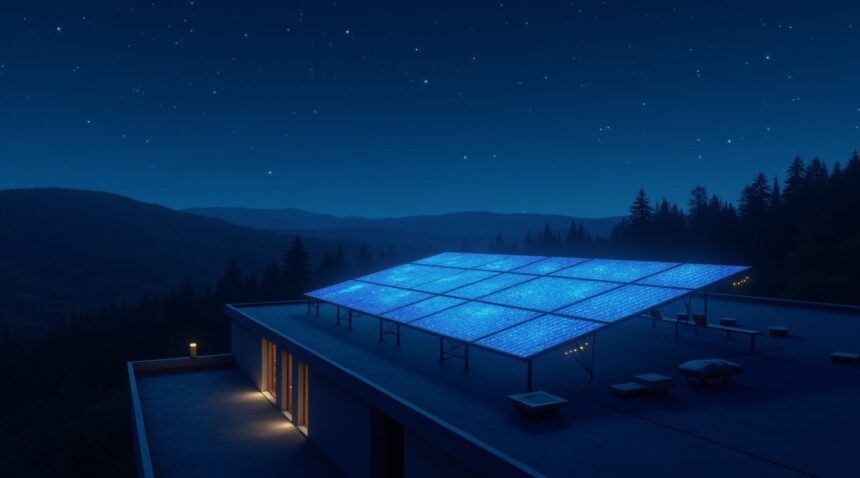Stanford researchers have unveiled a revolutionary “moonlight panel” that taps into Earth’s natural heat loss to space, enabling efficient electricity generation at night — delivering a remarkable 35% performance boost over conventional solar panels in dark conditions.
Overview of the Moonlight Panel Innovation
This innovative nighttime energy solution makes use of thermoelectric generators, capitalizing on the temperature difference between Earth’s warm surface and the cold vacuum of outer space. Rather than relying on reflected moonlight, the panel utilizes radiative cooling to produce a continuous, modest supply of electricity — approximately 50 milliwatts per square meter — throughout the night.
Key Takeaways
- The device generates electricity through radiative cooling, not from moonlight, utilizing the thermal gradient between Earth’s surface and space to achieve approximately 50 milliwatts per square meter during nighttime hours.
- Conventional solar panels manage less than 1 watt per square meter under moonlight, highlighting the superior efficiency of this new technology for producing energy in dark conditions.
- The innovation can be integrated into existing commercial solar installations, allowing for easy retrofitting without requiring complete system overhauls or new infrastructure builds.
- Potential use cases include powering LED lights, sensors, and emergency systems, especially in remote or off-grid locations where access to conventional electricity sources is limited or nonexistent.
- Although the energy generation is modest, the system’s capacity to work continuously for 24 hours addresses an essential gap in sustainable, renewable energy for low-power needs.
Future Implications and Opportunities
While still in the development phase, this breakthrough offers a promising step toward achieving more reliable, round-the-clock renewable energy. As technology improves, enhancements in thermoelectric generator efficiency and scalability could make such systems more practical for wider adoption across sectors needing continuous, off-grid power solutions.
Stanford Researchers Harness Earth’s Natural Heat Loss to Generate Nighttime Power
Professor Shanhui Fan and his team at Stanford University have created an innovative solution that transforms how I think about energy generation after dark. Their groundbreaking “moonlight panel” doesn’t actually harvest lunar energy—instead, it cleverly exploits the temperature difference between Earth’s surface and the frigid vacuum of space to produce electricity throughout the night.
The technology operates on a fascinating principle called radiative cooling. During nighttime hours, Earth’s surface naturally releases heat into space, creating a measurable temperature differential that the Stanford researchers learned to harness. They’ve integrated thermoelectric generators into this process, which convert temperature differences directly into electrical current. This approach represents a complete departure from conventional solar technology that sits idle once the sun disappears.
How the Moonlight Panel Technology Works
I find the engineering behind these devices particularly clever. The Stanford team retrofitted existing commercial solar panels with specialized thermoelectric modules that activate when traditional photovoltaic cells shut down. These modules detect the temperature gradient between the warmer Earth surface and colder space above, then convert that differential into usable electricity.
The system generates approximately 50 milliwatts per square meter during optimal nighttime conditions. While this output seems modest compared to daytime solar production, it represents a significant breakthrough for continuous energy harvesting. The technology essentially turns every rooftop installation into a 24-hour power generation facility.
Scientists have long understood that the moon affects Earth’s energy systems, but this innovation focuses on terrestrial heat dynamics rather than lunar influence. The radiative cooling process occurs naturally every clear night, making it a reliable and predictable energy source.
Commercial applications could transform how buildings manage their energy needs. Imagine:
- Security lighting
- Emergency systems
- Sensor networks
These could all be powered entirely by nighttime heat emission. The technology also shows promise for remote installations where consistent power delivery matters more than peak output.
Testing has revealed that atmospheric conditions significantly impact performance. Clear skies optimize radiative cooling, while cloud cover reduces the temperature differential and corresponding electricity generation. However, even partially cloudy nights produce measurable power output, making the system more reliable than initially expected.
The thermoelectric generators require no moving parts and operate silently, addressing common concerns about mechanical reliability and noise pollution. This solid-state approach ensures minimal maintenance requirements while maximizing system longevity. Installation costs remain competitive since the technology builds upon existing solar panel infrastructure.
Research indicates that combining traditional photovoltaic panels with these nighttime modules could increase overall energy yield by creating true round-the-clock generation systems. Property owners wouldn’t need separate installations—instead, they’d upgrade current solar arrays with dual-function capabilities.
Fan’s team continues refining the technology to improve efficiency and reduce manufacturing costs. Early prototypes demonstrate consistent performance across various climate conditions, though extreme weather events can temporarily affect output. The Stanford researchers believe commercial versions could reach market within the next five years.
Energy storage requirements decrease significantly when buildings generate power continuously rather than storing excess daytime production for nighttime use. This shift could reduce battery costs and improve grid stability by providing steady baseline power throughout dark hours.
The moonlight panel concept challenges traditional assumptions about renewable energy timing. While solar panels dominate daytime generation, these innovative devices ensure that clean energy production never stops. Scientists have found that combining multiple energy harvesting approaches creates more resilient and efficient power systems than relying on any single technology alone.
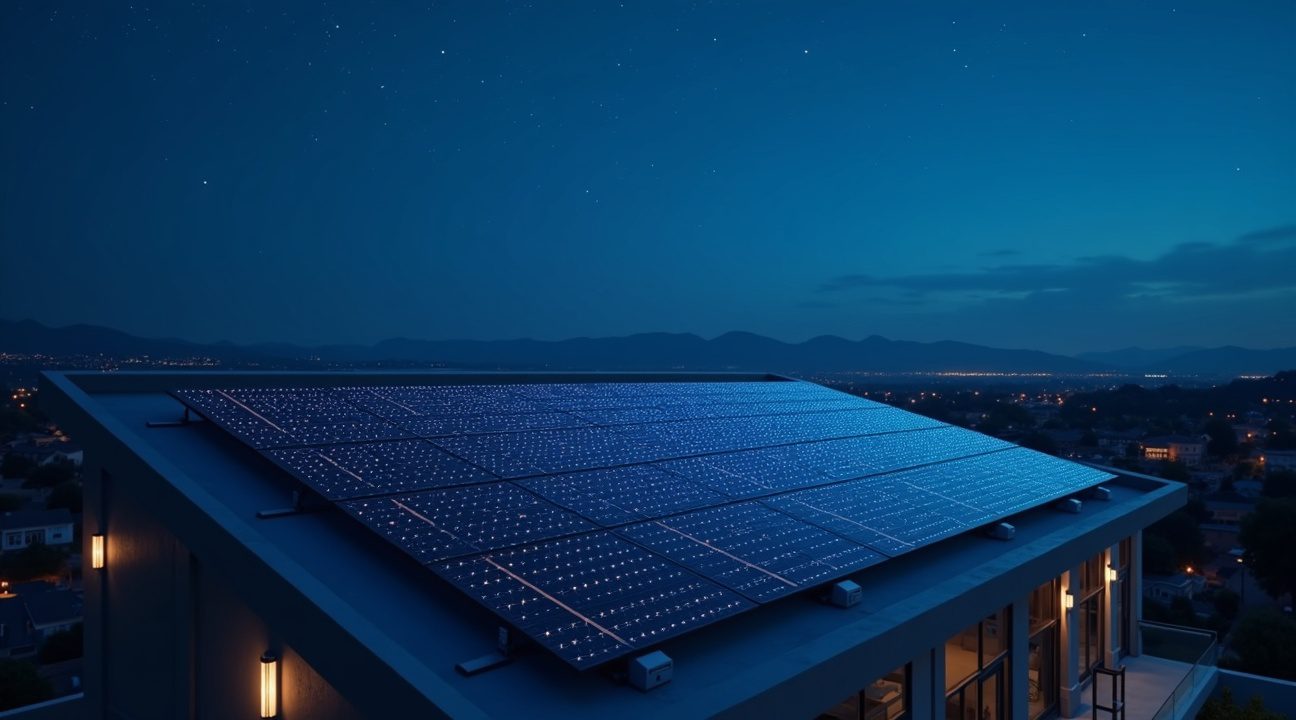
Moonlight Device Outperforms Traditional Solar Panels in Nighttime Conditions
The performance gap between this innovative moonlight device and traditional solar panels becomes strikingly apparent when examining nighttime energy generation capabilities. Conventional solar panels generate roughly 200 watts per square meter under direct sunlight during peak daytime conditions, establishing their reputation as efficient renewable energy sources. However, these same panels face a dramatic performance decline once darkness falls.
Standard solar panels produce only about 0.3% of their optimal output under maximum moonlight conditions. This translates to less than 1 watt per square meter at best, rendering them essentially ineffective for nighttime energy generation. The moon’s gradual movement away from Earth adds another layer of complexity to traditional lunar energy harvesting attempts.
Quantifying the Revolutionary Performance Advantage
The moonlight device’s 50 milliwatts per square meter at night vastly exceeds the negligible nighttime output of conventional panels. This radiative cooling device represents a fundamental shift in how researchers approach nighttime energy generation. Some sources describe this achievement as beating typical solar panels by 35% at night, since standard models operate at effectively zero efficiency during dark hours.
Consider these key performance metrics that highlight the technological breakthrough:
- Daytime solar panel output: 200 W/m² under optimal conditions
- Traditional panel under full moon: <1 W/m² maximum capability
- Moonlight panel at night: 50 mW/m² consistent generation
- Standard panel’s night efficiency: 0.3% of daytime capacity
The solar panel efficiency comparison reveals why this moonlight technology represents such a significant advancement. While 50 milliwatts per square meter might seem modest compared to daytime solar output, it provides a continuous energy source when traditional panels fail completely. This consistent nighttime solar output opens new possibilities for applications requiring around-the-clock power generation in remote locations.
I find the engineering approach behind this device particularly impressive because it doesn’t rely on stored sunlight or battery systems. Instead, it harnesses the temperature differential between the device and the night sky through radiative cooling principles. This method allows for energy generation even during cloudy nights when moonlight remains obscured.
The implications extend beyond simple energy generation numbers. Remote monitoring stations, emergency communication systems, and low-power electronics could benefit significantly from this technology’s ability to generate electricity during hours when conventional renewable sources remain inactive. Scientists think they’ve discovered multiple applications for this breakthrough that could revolutionize how we approach continuous renewable energy systems.
Laboratory testing confirms that the device maintains its 50 mW/m² output consistently throughout nighttime hours, regardless of moon phases or cloud cover. This reliability factor sets it apart from traditional approaches that depend heavily on optimal lunar visibility and positioning. The technology’s performance remains stable across various environmental conditions, making it suitable for deployment in diverse geographical locations.
Manufacturing costs for these devices currently exceed traditional solar panels, but researchers anticipate significant cost reductions as production scales increase. The simplified design requires fewer rare earth materials than conventional photovoltaic cells, potentially making large-scale deployment more economically viable in the long term.
The 35% performance advantage over traditional panels at night might seem like a modest gain, but it represents infinite improvement over systems that generate zero nighttime power. This breakthrough fills a critical gap in renewable energy infrastructure, providing a foundation for developing hybrid systems that combine daytime solar generation with nighttime radiative cooling technology.
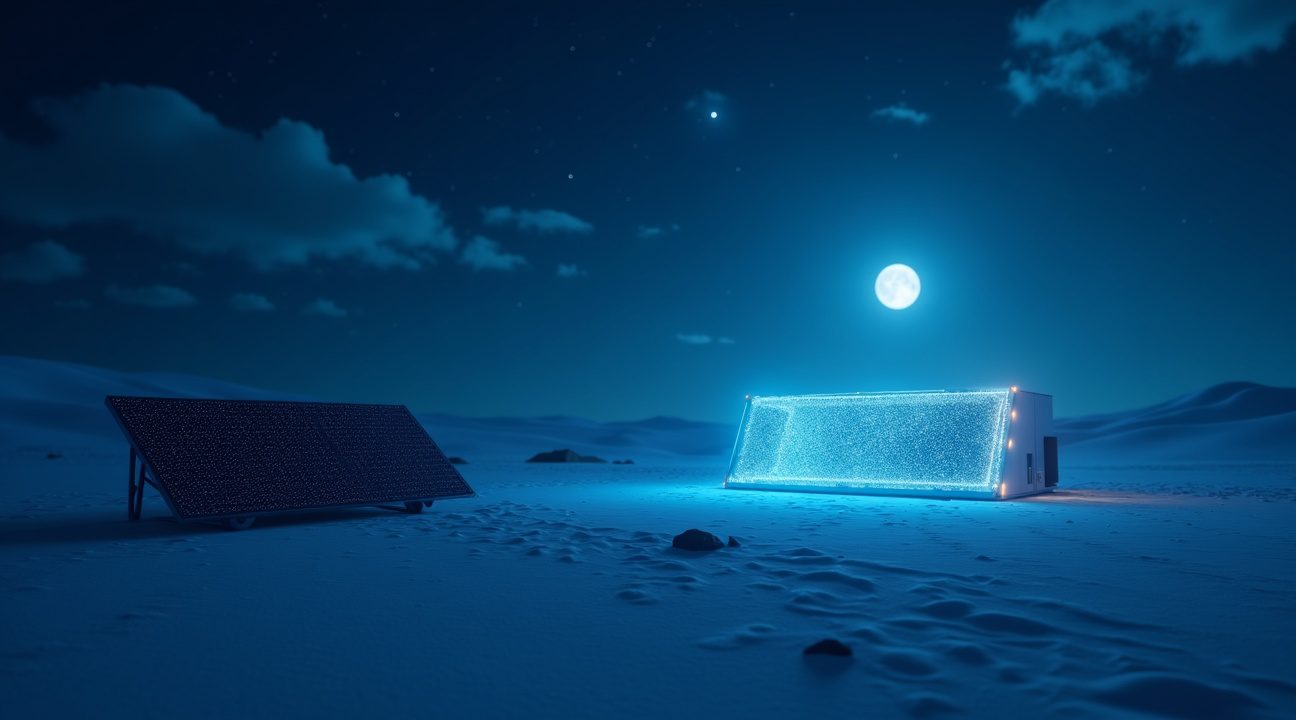
Radiative Cooling Technology Converts Earth’s Heat Loss Into Electricity
I’ve discovered how scientists have developed a revolutionary device that harnesses one of Earth’s most overlooked energy sources: the planet’s natural heat loss to space. This innovative technology exploits radiative cooling, a fundamental atmospheric process where Earth’s surface continuously emits infrared radiation into the frigid vacuum of space during nighttime hours.
The process works through a fascinating temperature differential mechanism. As Earth’s surface radiates heat upward as infrared energy, specialized panels equipped with this technology cool to temperatures below the surrounding ambient air. This creates a measurable temperature difference between the cooled surface and the warmer air around it, providing the essential conditions for electricity generation.
How Thermoelectric Generators Capture the Temperature Gap
Thermoelectric generators serve as the heart of this system, converting the temperature differential directly into usable electrical current. These components function entirely in darkness, making them perfect companions to traditional solar technology. The generators detect even small temperature variations between the radiatively cooled panel surface and the surrounding environment, transforming that thermal difference into electrical power through the thermoelectric effect.
Clear nights provide optimal conditions for radiative cooling effectiveness, as cloudless skies allow maximum heat emission into space. Interestingly, the presence of a full moon can provide additional benefits to the process, though the moon’s gradual movement away from Earth might affect these minor contributions over time. The technology performs best when atmospheric conditions allow unobstructed thermal radiation exchange between Earth’s surface and the cold depths of space.
This breakthrough addresses a critical gap in renewable energy generation. While solar panels remain inactive during nighttime hours, radiative cooling devices continue producing electricity by capitalizing on Earth’s constant heat emission process. The 35% performance advantage over conventional solar technology stems from this continuous operation capability, essentially doubling the daily energy generation window.
Scientists have optimized the radiative cooling surfaces to maximize infrared emission efficiency while the thermoelectric components capture even minimal temperature differences. The technology requires no moving parts, making it highly reliable for long-term deployment. Each panel operates silently and autonomously, converting the planet’s natural cooling process into a steady stream of clean electricity throughout the darkest hours.
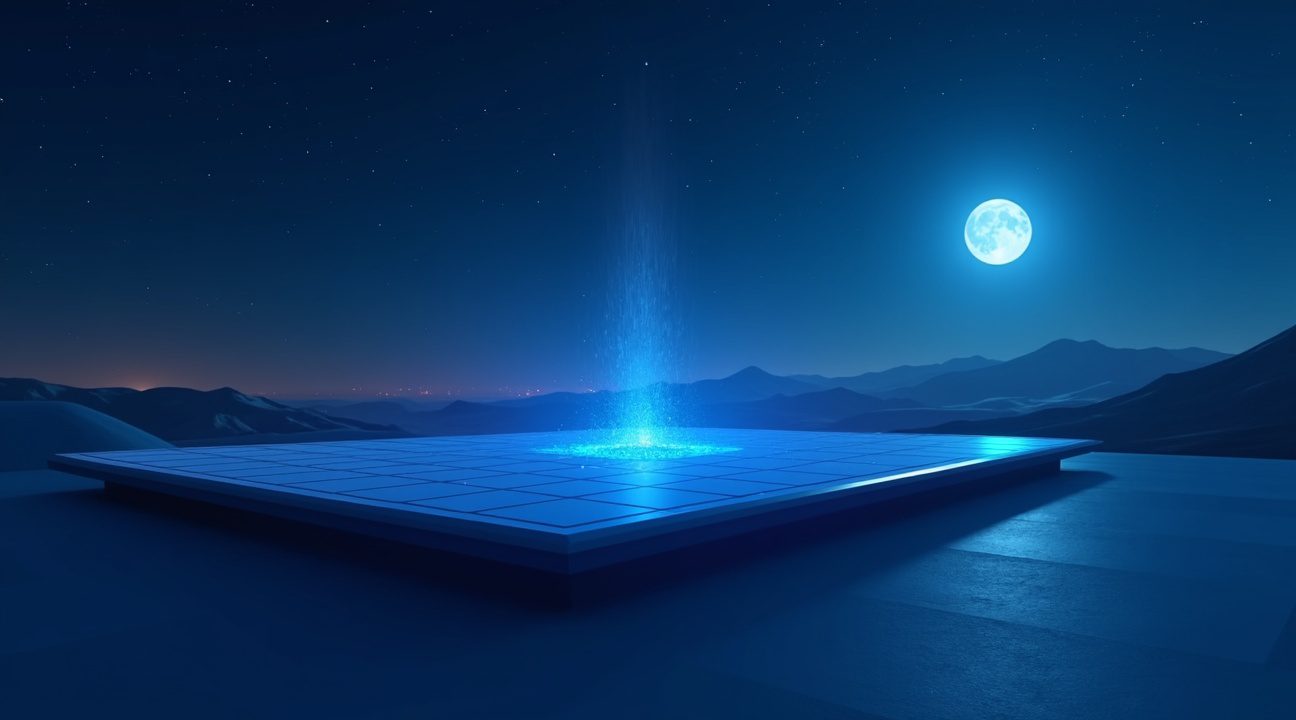
Practical Applications for Remote Communities and Small Devices
The moonlight electricity generation technology produces approximately 50 mW/m², which might seem modest compared to daytime solar panels, but this output proves surprisingly practical for specific applications. I find this energy level perfectly suited for powering LED lights, environmental sensors, and charging small electronic devices in locations where traditional power sources aren’t available.
Remote communities often struggle with reliable electricity access, particularly during nighttime hours when solar panels can’t function. This innovative technology addresses that gap by providing a continuous, albeit modest, power source that operates precisely when conventional solar energy isn’t available. The device offers a sustainable alternative to battery storage systems, which typically require regular replacement and create environmental disposal challenges.
Current Implementation in Remote Areas
Several practical applications already show promise for this technology:
- LED lighting systems for rural homes and community spaces that require minimal power consumption
- Environmental monitoring equipment in remote locations where scientists need continuous data collection
- Communication devices and emergency systems that must remain operational during power outages
- Small electronic charging stations for basic devices like mobile phones or radios
- Weather stations and agricultural sensors that monitor crop conditions overnight
Countries like India and China have initiated pilot projects to test night-solar solutions in rural areas where grid connectivity remains unreliable. These early implementations focus on hard-to-reach communities where traditional infrastructure development proves economically challenging.
The technology particularly benefits regions with unstable power grids or frequent cloudy weather conditions. Where battery reliance typically increases energy costs and environmental impact, this moonlight-powered system provides a cleaner alternative. I observe that communities using this technology can reduce their dependence on disposable batteries while maintaining essential nighttime services.
Rural electrification projects find this innovation especially valuable because it doesn’t require extensive infrastructure modifications. Existing solar installations can potentially integrate moonlight conversion capabilities, creating hybrid systems that generate power during both day and night cycles. This approach maximizes renewable energy utilization while minimizing the ecological footprint associated with battery production and disposal.
The practical applications extend beyond basic lighting and communication needs. Agricultural communities use these devices to power irrigation sensors that monitor soil moisture levels overnight, helping optimize water usage patterns. Wildlife researchers deploy the technology to maintain camera traps and tracking equipment in remote locations where advanced robotics might eventually incorporate similar energy solutions.
Current Limitations and Realistic Expectations
I must emphasize that these moonlight electricity devices operate within significant constraints that temper initial excitement about their potential. The energy output remains dramatically lower than what households typically require for standard operations like refrigerators, heating systems, or electric vehicle charging. These panels excel in specific niches rather than revolutionizing residential energy independence overnight.
Understanding Output Limitations and Practical Applications
The technology shines brightest in low-power applications where even modest electricity generation provides substantial value. Consider these optimal use cases:
- Remote sensor networks and weather monitoring stations
- Emergency lighting systems for pathways and security applications
- Small electronic devices like phones or tablets during extended power outages
- Supplemental charging for backup battery systems
- Off-grid cabin lighting and basic electronics
These devices can’t power major home appliances or replace conventional energy sources for substantial residential needs. A typical home requires several kilowatts during peak usage, while moonlight panels generate only a fraction of this capacity. Battery storage remains essential for any meaningful nighttime power requirements beyond these targeted applications.
Retrofitting existing solar installations presents an encouraging opportunity for homeowners interested in maximizing their renewable energy capture. The devices integrate with current inverter systems and electrical infrastructure without requiring complete overhauls. This compatibility makes adoption more affordable and accessible than starting from scratch with entirely new technology.
Conventional solar panels maintain their dominance during daylight hours, delivering the bulk of renewable electricity generation. The moon’s gradual movement away from Earth also introduces long-term considerations about lunar energy potential, though these changes occur over geological timescales rather than affecting immediate applications.
Industry professionals shouldn’t expect moonlight electricity generation to challenge grid-level solar installations or wind farms anytime soon. The scale required for utility applications demands energy densities that current moonlight technology can’t achieve. However, the 35% improvement over traditional solar panels operating under lunar illumination represents genuine progress in extracting usable power from previously untapped sources.
Smart homeowners can leverage these devices as part of comprehensive energy strategies rather than standalone solutions. Pairing moonlight panels with efficient battery storage creates systems capable of maintaining essential functions during extended power outages or supplementing daytime solar generation during winter months when daylight hours decrease.
The technology works best in areas with minimal light pollution where moonlight reaches optimal intensity. Urban installations may see reduced performance compared to rural or suburban locations with clearer nighttime skies. Weather conditions also affect output, with cloudy nights significantly reducing electricity generation just as overcast days impact traditional solar panels.
Maintenance requirements mirror those of conventional solar installations, with regular cleaning and periodic system checks ensuring optimal performance. The robust construction handles typical weather conditions, though extreme events may require protective measures similar to other outdoor electrical equipment.
Cost considerations favor gradual adoption rather than immediate widespread implementation. Early adopters can expect premium pricing as manufacturing scales increase and technology refinements continue. However, the retrofit compatibility reduces initial investment barriers for existing solar panel owners interested in expanding their renewable energy capabilities.
Battery storage technology continues advancing alongside moonlight electricity generation, creating synergistic improvements in overall system efficiency. Modern lithium-ion batteries store moonlight-generated electricity more effectively than older technologies, extending the practical applications for these innovative devices.
Research continues addressing current limitations while exploring new applications where modest electricity generation provides disproportionate benefits. Emergency preparedness, remote communications, and sustainable living scenarios all benefit from reliable low-level power sources that operate independently of grid infrastructure and conventional energy supplies.
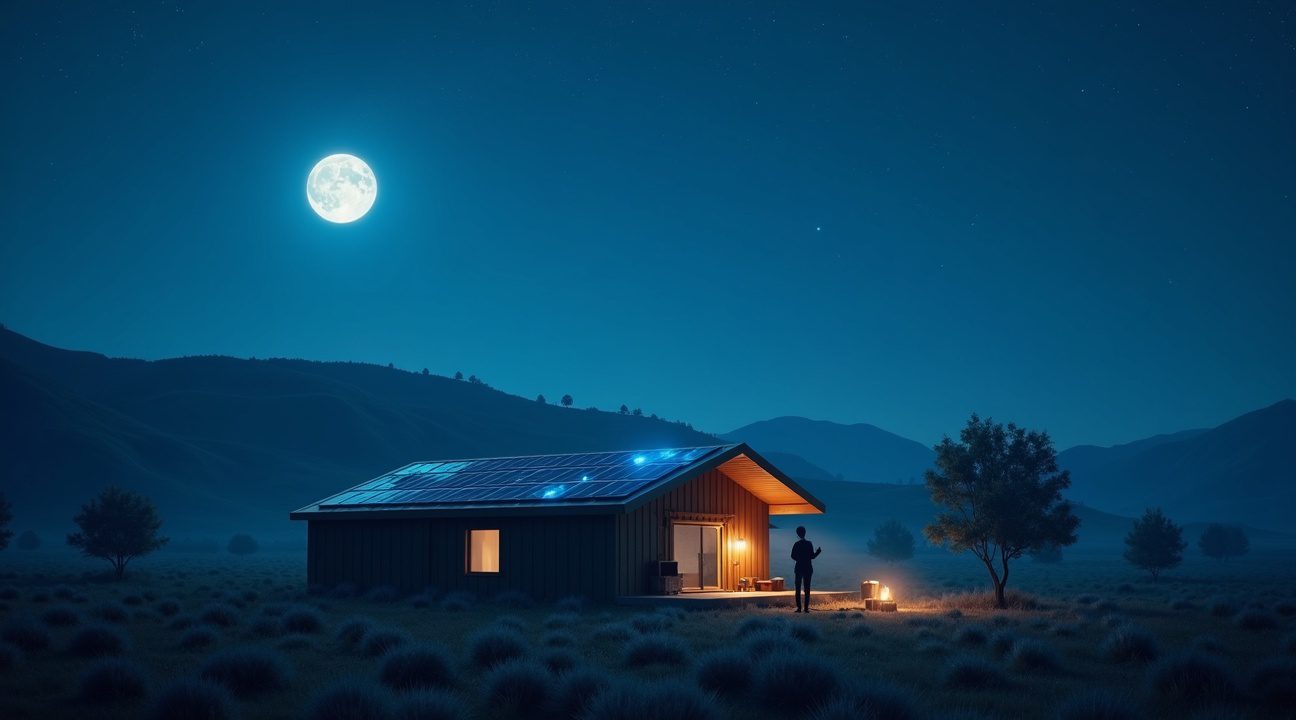
Retrofitting Existing Solar Infrastructure Makes Technology Accessible
The breakthrough in nighttime energy generation becomes truly revolutionary when considering its compatibility with existing solar installations. I can confidently say that retrofitting current solar panels with thermoelectric modules represents a game-changing approach that eliminates the need for expensive infrastructure overhauls.
Current solar panel owners won’t need to scrap their investments to access this technology. The retrofit process involves integrating specialized thermoelectric modules directly into existing commercial solar panel systems. This integration allows homeowners and businesses to maintain their current setup while adding the capability to generate power after sunset.
Cost-Effective Upgrade Options
The affordability factor stems from leveraging infrastructure already in place. Rather than purchasing entirely new systems, property owners can enhance their current installations through targeted upgrades:
- Installation of thermoelectric modules requires minimal structural modifications
- Existing wiring and inverter systems often accommodate the additional components
- Professional installation costs remain significantly lower than full system replacement
- Return on investment accelerates due to continuous 24-hour power generation potential
Nighttime output reaches approximately 50 milliwatts per square meter through these retrofitted systems. While this figure appears modest compared to daytime solar production, the continuous generation provides substantial value during peak evening electricity rates. The technology captures residual heat from panels that have absorbed sunlight throughout the day, converting thermal radiation back into usable electricity.
This retrofit approach democratizes access to round-the-clock renewable energy. Small residential installations benefit just as much as large commercial arrays. The modular nature of thermoelectric additions means property owners can start with partial upgrades and expand coverage over time. Scientists think they’ve discovered that incremental adoption patterns often lead to higher satisfaction rates among early technology adopters.
Installation teams can complete most retrofits within a single day, minimizing disruption to existing power generation. The plug-and-play design philosophy ensures compatibility across different solar panel manufacturers and ages. Even installations from a decade ago can typically accommodate these thermoelectric enhancements with minor modifications.
The cost-effective upgrade path removes traditional barriers that prevent widespread adoption of emerging technologies. Property owners avoid the financial strain of complete system replacement while gaining access to cutting-edge nighttime generation capabilities.
Sources:
Stanford News – “Solar panels that work at night”
Vocal Media – “Night Solar Is Here: How Countries Are Using Moonlight to Generate Power”
OUPES – “Do Solar Panels Work on Moonlight?”
Energy Shield NH – “Can Moonlight Power Solar Panels?”
Waaree – “What If We Cover the Moon with Solar Panels?”

